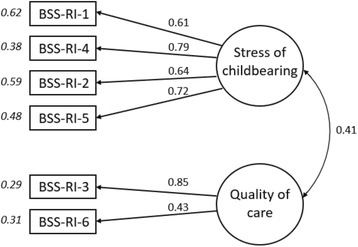The Birth Satisfaction Scale-Revised Indicator (BSS-RI)
- PMID: 28851307
- PMCID: PMC5575858
- DOI: 10.1186/s12884-017-1459-5
The Birth Satisfaction Scale-Revised Indicator (BSS-RI)
Abstract
Background: The current study sought to develop a short birth satisfaction indicator utilising items from the Birth Satisfaction Scale-Revised (BSS-R) for use as a brief measure of birth satisfaction and as a possible key performance indicator for perinatal service delivery evaluation. Building on the recently developed BSS-R, the study aimed to develop a simplified version of the instrument to assess birth satisfaction easily that could work as a short evaluative measure of clinical service delivery for labour and birth that is consistent with policy documents, placing women at the centre of the birth experience.
Methods: The six item Birth Satisfaction Scale-Revised Indicator (BSS-RI) was embedded within the 2014 National Maternity Survey for England. A random selection of mothers who had given birth in a two week period in England were surveyed three months after the birth. Using a two-stage design and split-half dataset, exploratory factor analysis, confirmatory factor analysis, internal consistency, convergent, divergent and known-groups discriminant validity evaluation were conducted in a secondary analysis of the survey data.
Results: Using this large population based survey of recent mothers the short revised measure was found to comprise two distinct domains of birth satisfaction, 'stress and emotional response to labour and birth' and 'quality of care'. The psychometric qualities of the tool were robust as were the indices of validity and reliability evaluated.
Conclusion: The BSS-RI represents a short easily administered and scored measure of women's satisfaction with care and the experience of labour and birth. The instrument is potentially useful for researchers, service evaluation and policy makers.
Keywords: Birth satisfaction; Birth satisfaction scale; Service evaluation.
Conflict of interest statement
Ethics approval and consent to participate
The study was approved by the National Research Ethics Service committee for Yorkshire and The Humber – Humber Bridge (REC reference 14/YH/0065. Consent was assumed on questionnaire completion and return.
Consent for publication
Not applicable.
Competing interests
All authors declare that there are no conflicts of interest.
Publisher’s Note
Springer Nature remains neutral with regard to jurisdictional claims in published maps and institutional affiliations.
Figures

References
-
- Department of Health . Changing childbirth: report of the expert maternity group (Cumberlege report) London: HMSO; 1993.
-
- Department of Health . The National Service Framework for children, young people and maternity services. London: Department of Health; 2004. - PubMed
-
- Department of Health . Maternity matters: choice, access and the continuity of Care in a Safe Service. London: Department of Health; 2007.
-
- The Care Quality Commission: Towards Better Births. London; 2008.
-
- Redshaw M, Heikkila K. Delivered with care: a National Survey of Women’s experience of maternity care. Oxford: National Perinatal Epidemiology Unit, University of Oxford; 2010.
Publication types
MeSH terms
LinkOut - more resources
Full Text Sources
Other Literature Sources
Medical

